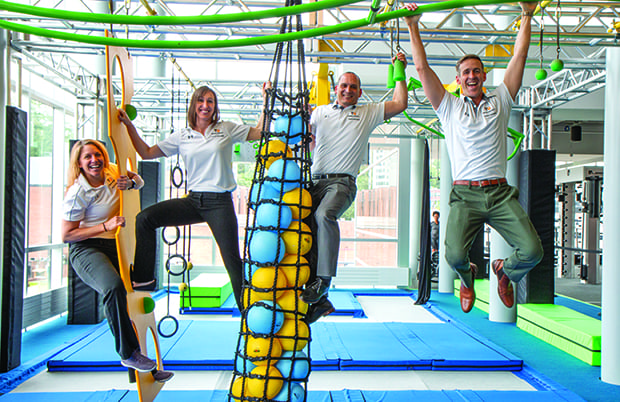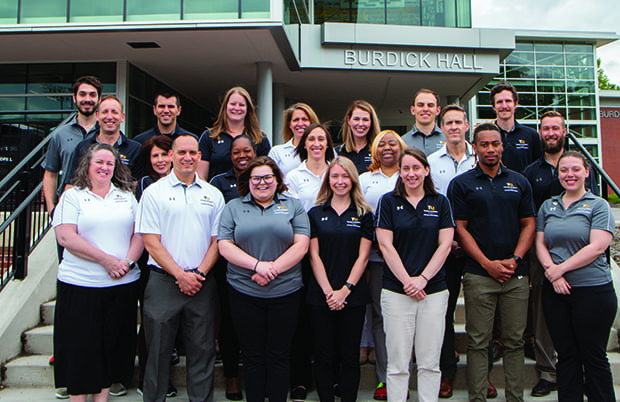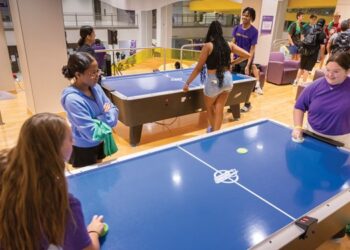When Grady Sheffield was interviewing at Towson University (TU) in 2010, there wasn’t any mention of a rec center expansion.
He found out about it during orientation, and a few months later, Sheffield got the call that the project would be started. Often, he would drive home from work and wonder what he’d got himself into.
However, January 2019 saw the one-year anniversary of the expansion. Burdick Hall is no longer the box of bricks it once was. It has walls of windows, letting in light and action as a lantern in the heart of campus at TU. Inside, the building now has 22,000 square feet of fitness space, five studios, three gyms and more. It finally has all the tools to meet the needs of Towson students.
But, it didn’t come without challenges. Like any project, there were cuts. And one thing that had to go was the track. However, Sheffield found a compromise: a 30-yard sprint hill at 20 percent pitch, with an additional 35 yards of incline leading up to it. Since there’s no track, the hill reaches the top and ends in a small overlook of the functional fitness floor below. “We have this hill to nowhere,” recalled Sheffield, as he looked at the design. “What are we going to do with it?”
The answer was an obstacle course.
The entire section below the sprint hill is full of functional fitness. From tires to flip and boxes to jump on, to a Queenax and turf, the idea was to create a space for circuits to be performed. A student could sprint up the hill, fly down the stairs — of which there are two sets, one simulating stadium stairs so students can work out on them — go through The Jungle, push a sled, and then do it all over again.

The best part? The Jungle can be removed should it ever stop meeting the needs of students. Problem solving issues like this was just one of the challenges. Sheffield said if he had to do the project again, he wouldn’t do it the same way. In fact, one tip he gave would be to pay more attention to the finishes. For example, the location of the outlets in the offices were in the wrong spots. Or, Sheffield wishes they had the studios on the inside versus facing the outside because there isn’t as much activity in them during the day. He said it came down to a lack of understanding and interpretation in how the plans would translate into the real thing.
Despite the challenges, Burdick Hall has seen a double in the amount of daily visits from before the expansion.
In fact, tracking these numbers is a big deal in the campus recreation department that boasts a culture of assessment. Katie White, the associate director of programming and assessment, has spearheaded the love for data in the department.
She said it started with revamping their annual 10-page, black-and-white, 12-point font report. Adding pictures, quotes and more, it became a piece of work to show off to family and friends. “Now we have this beautiful scrapbook of what we’ve done all year,” she said. “That was the original snowball that made the snowman that is now our assessment program.”
The ways data is collected and used are vast. But White ultimately looks to empower everyone on staff to see the use and benefit of data. One way this has been accomplished is by requiring each program supervisor to do a yearly assessment. White explained they work to come up with a meaningful assessment that excites the staff member and will improve their program.
Plus, every other week, the staff has a communications meeting. They can present data here and share it with their peers. “I’m adamant with our staff that we do not hoard data,” said White.
Another way data is used at Towson is in its “You Asked, We Listened” educational campaigns. White explained they survey students about their experience at campus rec. Then, they use digital signage to display the questions and the changes that have taken place. For example, in the fall 2018 survey, students said they wanted boxing classes. White said they already had boxing classes, just under the name Total Knockout (TKO). They realized the name was confusing students, so they changed the language of the classes to “boxing circuit” and “boxing skills.”
All in all, data is powerful, and Sheffield said it allows them to speak the language of student affairs. This keeps campus rec from getting overlooked. “My goal is I want the university to recognize Towson University is not a successful university without a successful campus rec program,” he said. “I can beat my chest as loud as I want trying to get people to understand that, but the only way I am going to get that message understood is through assessment.”

Another way campus rec is making an impact on campus and its students is through sport clubs. A tier system designates clubs as tier one through five. As clubs gain tiers, they get benefits, like facility priority and more funding. However, their responsibilities and expectations in areas like fundraising and event participation increase as well.
But, the impact of the sport clubs doesn’t end there. Jeff Keenan, the assistant director of competitive sports, said the program also has a leadership aspect. “Our program is unique in that all of our sport clubs programs meet with their assigned sport club supervisor every week, for about 15 to 30 minutes,” said Keenan.
Six supervisors are each assigned four to six clubs. The meetings between the supervisor and the head of each club consist of reflection, questions on how he or she would respond in varying situations, solve challenges and mentor the sport clubs leaders.
The idea is to develop students through building and articulating transferable skills. Keenan said they are continually asking how they can prepare students for employment and aim to help them apply work experience in campus rec to various career paths.
He once asked the sport clubs if they should get rid of those weekly meetings with their supervisors. The response was an adamant “no” as they saw the value in it, and Keenan suggested other club programs look into something similar. “They might resist it at first, because it’s another requirement, but over time I think they’ll feel value in it,” he said.
In the end, Sheffield said it’s key to recognize the potential students have to lead and execute. “They just need to be guided in the right direction, and they want to do this. They want to lead,” he explained.
Because one day, students will leave. They will visit Burdick Hall for the last time, and they will move on to the future. Campus recreation at Towson hopes to prepare them for that.
In many ways, as Burdick Hall sits at the gateway to campus, it is also acting like a gateway for students to bridge over into the real world. As Sheffield noted, it will continue to do its part in being a beacon, which lights the way for students on campus and beyond.
And like Towson’s students who are heading toward a bright future, Burdick Hall is doing the same. The building sits at the intersection for student life, and though the expansion work is complete, the work of campus recreation is far from finished. “Building the facility and opening the facility isn’t it,” said Sheffield. “There’s more to come for Towson campus recreation.”










